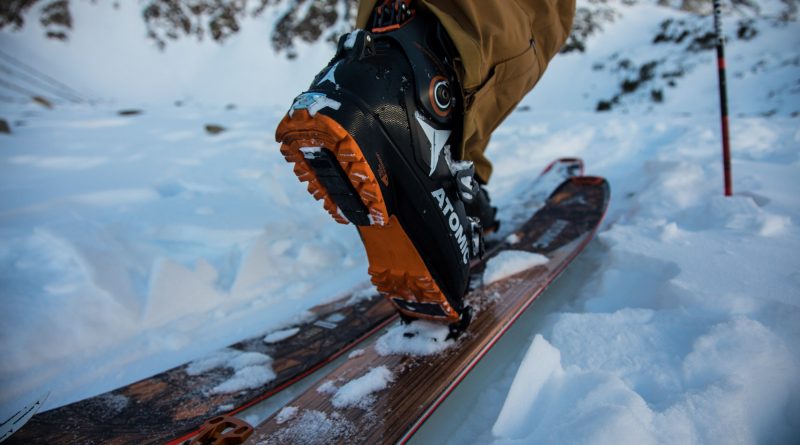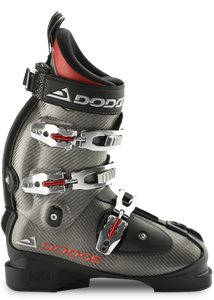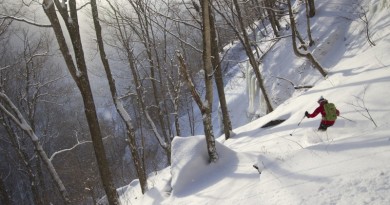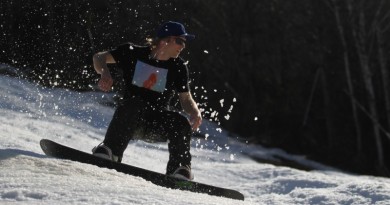8 Great All-Terrain Ski Boots
These new all-terrain ski boots were made for walking .. and ripping… and heading anywhere on piste, off-piste and in-between.
If you haven’t bought new boots in the past few years, wake up. Gone are the days of heavy ski boots that feel like lead weights as you walk to the lift. Alpine boots have learned a lot from the explosion of backcountry “AT” or alpine touring gear.
Today, you can have a fully rippable boot with all-day comfort…and the ability to free your heel to do a little uphill slog. This is a combo that didn’t really exist five or so years ago. “A lot of skiers want one boot to do it all,” says Dalbello’s Geoff Curtis. “Skin up in the morning, downhill ski all over the mountain, hike the summit and maybe go touring in the afternoon.”
It’s not just the uphill or sidehill skiers who are benefitting. Across the new lines, new shells and liners are easily customized to anyone’s foot. There are cuffs that release and soles that are rockered for much easier walking around. And no question: being able to unlock the cuff from the classic forward skiing lean makes for a much better experience when standing around with a coffee.
These new rockered soles still have enough hard plastic to release safely from your bindings, but the base is a soft, grippy rubber that can keep you from falling on your butt on the back deck of the lodge.
The rocker also creates a much smoother stride when hiking around on rocks and the added agility makes you feel much more like an athlete, and less like Frankenstein when crossing the parking lot.
The weight savings is one of the first things you will
notice when you grab a new boot off the wall of a ski shop, thanks to a variety of new materials. Vermont ski racer David Dodge pioneered the first carbon fiber boot. The alpine boot is stiff enough that ex-World Cup racers like it (it is available with a super-stiff 150 flex) but weighs a mere 1,600 grams compared with a typical race boot that weighs in at 2,400 grams.
Newer plastics like Grilamid can also seriously slim down a boot, while keeping it super strong for good skiing performance. The new 2018 Atomic Hawx Ultra 130 XTD, for instance, is a slim 1,420 grams, whereas the 2015 Atomic Hawx 2.0 130 was 2,174 grams. “We’ve also been able to fine tune how we use the materials in the cuff,” says Atomic’s Jake Strassburger. Liners are also much lighter while being completely customizable and comfortable.
While the lightest boots are ones dedicated to uphill travel, they will give up some downhill performance. They may also restrict which bindings you can use.
Look Into Your Sole
The classic race boot sole from the past few decades is referred to as conforming to ISO 5355 (International Standards Organization), and as having a DIN sole. This is what bindings have been built on for forever. Most new bindings will still take that style sole and many boots are still being made with it.
However, most new alpine bindings accept the rockered sole that AT boots use (as well as many alpine boots), conforming to ISO 9523. These new bindings go by names like WTR (Walk-to-Ride), Grip Walk and MNC (Multi Norm Compatible). Today, outside of race bindings, most new bindings will take ISO 9523 soles or AT boots. The other thing to consider is whether your new boot fits a tech binding.
On a “frame” binding, the entire frame of the binding lifts from the ski with your heel and most will take any type of boot. The other, lighter AT binding is a “tech” binding, which uses pins that fix the toe of the boot to the binding, allowing the heel to release on its own. These bindings require boots to have special “tech” inserts on the toe and heel of the boot. Some of the more touring-focused boots don’t even conform to ISO 9523 and will only fit in tech bindings—so when you fall in love with a new boot, make sure it will play nice with your bindings. (*Note: all the boot models on the opposite page are compatible with ISO 9523, except the Salomon; and tech bindings, except the Dodge.)
8 Great All-Terrain Boots
This year there is very much a continuum of boots for everyone from the high speed downhill skier, to the uphill ski racer (yeah, it’s a thing, look up “skimo”) and everyone can find the right boot to do what they do. Racers are still going to be skiing in a very classic ski boot that is built to do one thing: rip downhill at very high speeds. That’s all good for them, but most skiers are doing many things in their ski boots, and this new crop of alpine boots gives you the chance to do it all in one pair. For a few of our favorites, see below:
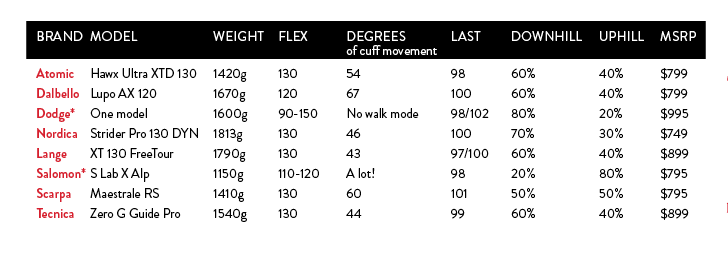
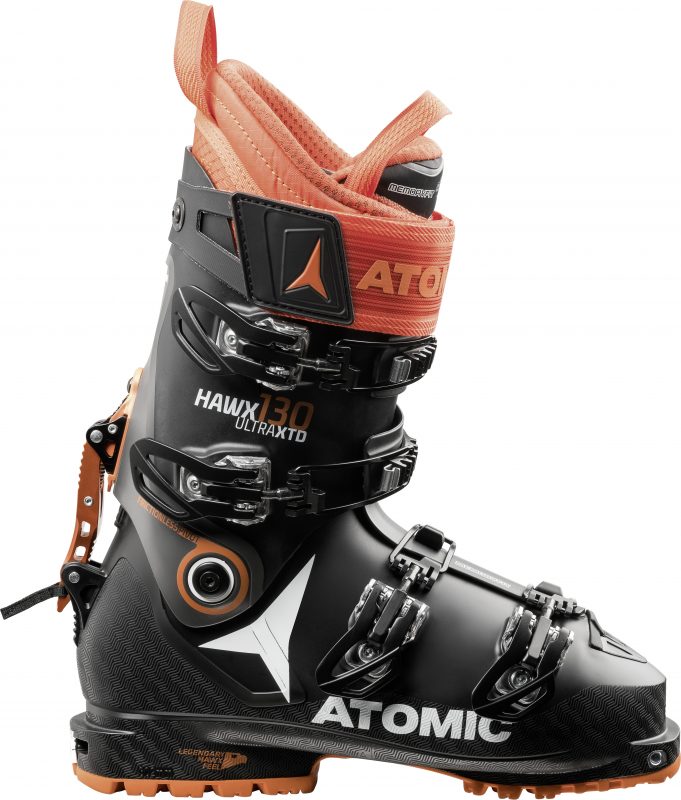
Atomic Hawx Ultra XTD
For 2018 Atomic has added the Hawx Ultra XTD. This great, new alpine touring addition has an easy-to use walk mode, and a Walk-to-Ride sole with tech fittings, so it will fit most modern step-in bindings, and pure tech bindings. The Ultra XTD still has Atomic’s Memory Fit shell and liner, so with a little heat in the shop, both the shell and liner can be molded to your feet and legs.
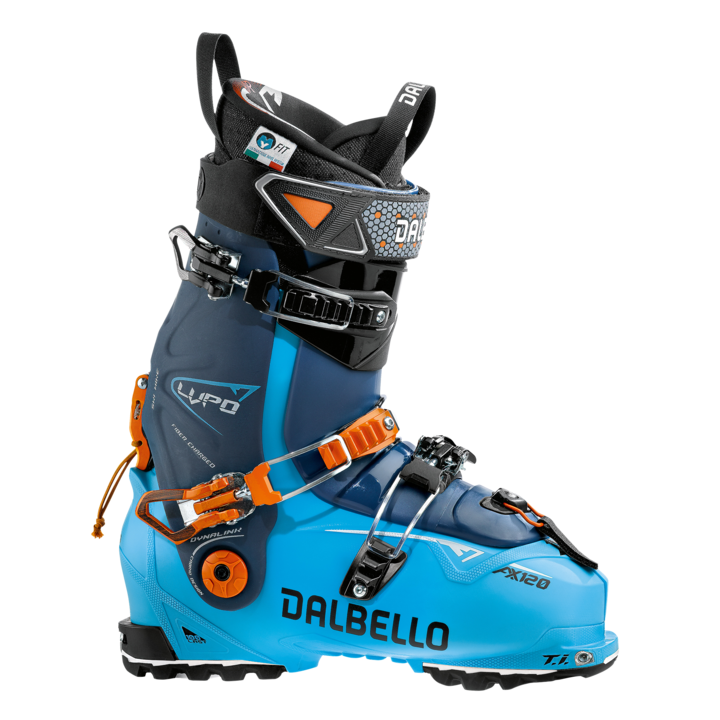
Dalbello Lupo AX 120
The new Lupo AX brings a 100mm last option to the Lupo family of light AT boots to compliment the 98-lasted Lupo Factory and Lupo 130 C. Dalbello is well known for its three-piece or cabrio shell design, and the Lupos are part of that heritage. The three-piece design refers to the lower shell, the cuff, and the tongue—in a traditional overlap or two-piece design, the tongue isn’t a separate piece of the shell. This gives the boots a great, progressive forward flex. It’s a smart design for a walk mode, because the front tongue can be removed when hiking and adds more range of motion and reduces weight. Dalbello also uses a liner that is heat moldable, very warm, and light.
The Dodge is not an AT boot, (it won’t fit in a tech binding and has no walk mode) but it’s light enough to play one for short hikes. Vermont’s David Dodge started making carbon boots for World Cup racers but the boots are so light (1600 grams) that they work for sidecountry slogs too. Add to that the fact that carbon doesn’t change shape in varying temperatures the way plastics do and the flex options of 100 to 150. Dodge also offers a 3D fitting app that you can download. Take a photo of your foot then upload it and they’ll customize the boot for your foot. That’s important since Dodge boots are only available by direct purchase —but you can visit the Essex, Vt. headquarters.
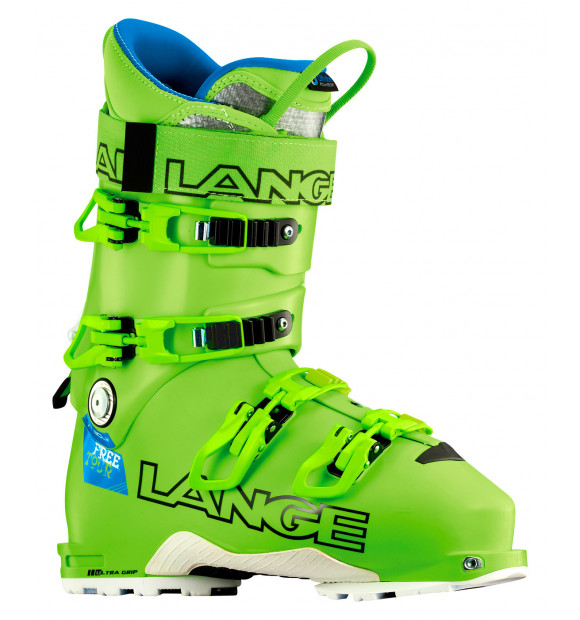 Lange XT 130 Freetour
Lange XT 130 Freetour
As a celebrated maker of stiff, powerful low volume race boots, Lange was a little late to the AT party. They first made the XT by adding a walk mode to the RX. Now, with tech binding fittings and Grilamid plastic, the XT 130 Freetour is a very hikable boot that still is low volume, and rips the downhills like a Lange should! And with lasts 97 or 100, it should fit a variety of feet.
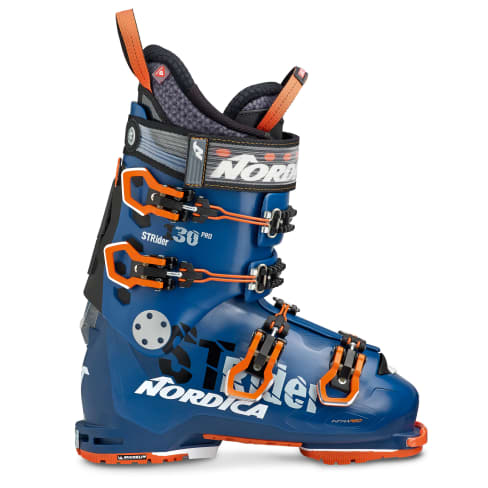 Nordica Strider Pro 130 DYN
Nordica Strider Pro 130 DYN
Nordica has taken their popular Speed Machine boots, and made them hike-friendly. The Strider Pro 130 is the stiffest of the pack: a great in-bounds boot that can do some good uphill climbing. “In the walk mode, the pivot point is high on the back of the cuff which gives it more torsional rigidity in the spine of boot, where all the power is,” explains Nordica’s Sam Beck. The fit is a bit more high-volume and for added comfort, Nordica has designed an infrared heating element that will heat specific parts of the boot to customize the fit. Another cool feature: the sole uses the same rubber tread Michelin uses in its snow tires. It’s also ready to go in a full tech binding, or any binding that will take a Grip Walk sole. You can also change out for a traditional alpine DIN sole.
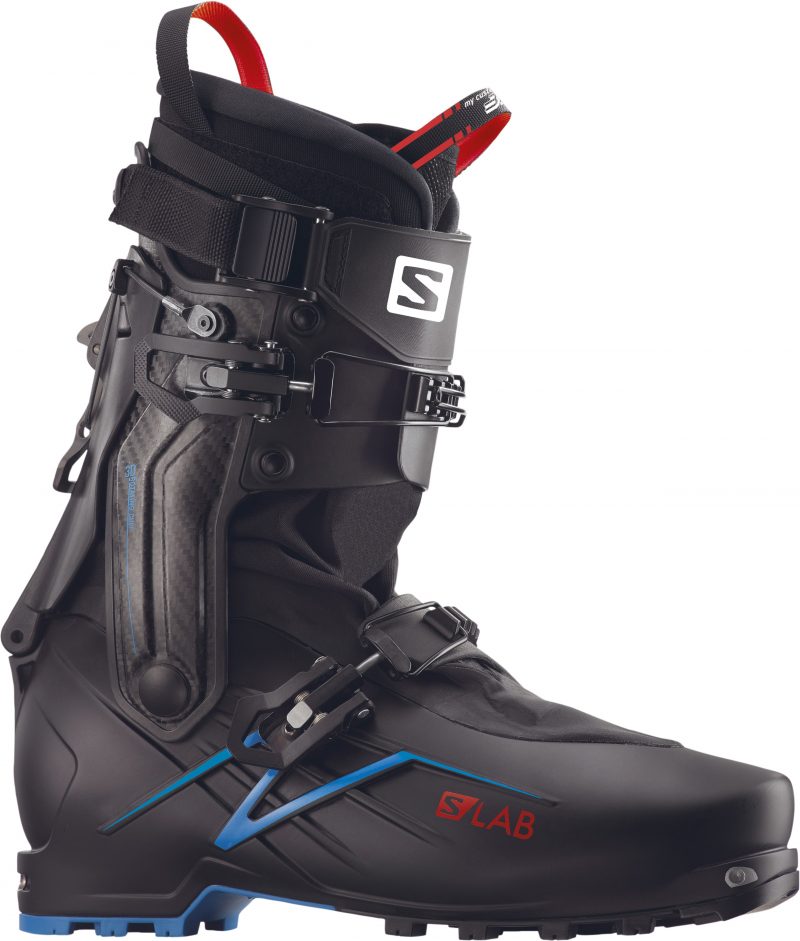
Salomon S Lab X Alp
This may be one of the best walking/touring boots out there. The way the cuff separates allows for great lateral movement as well as fore and aft freedom, making it agile when scrambling on mountain tops. This is a boot you could drive home in after skiing. Don’t let the two buckles make you think it won’t hug your foot, because this boot holds well and skis great.
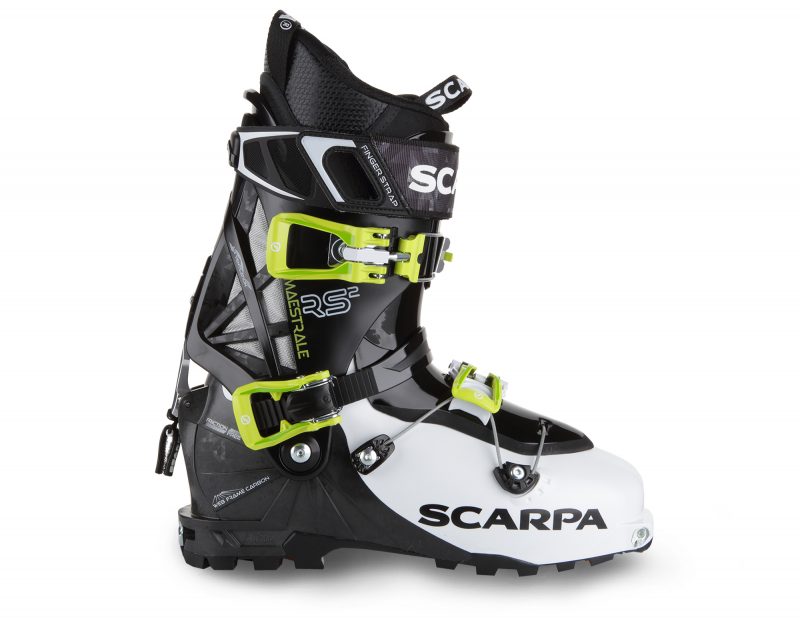
Scarpa Maestrale RS
Scarpa has long history of telemark and touring boots, and the new Maestrale line is raising the bar. This new RS is stiffer, has a more progressive flex, a huge range of motion in the cuff, and is significantly lighter than its predecessor. This boot is a great option for someone with a little higher volume foot, who wants light, but still needs solid downhill performance.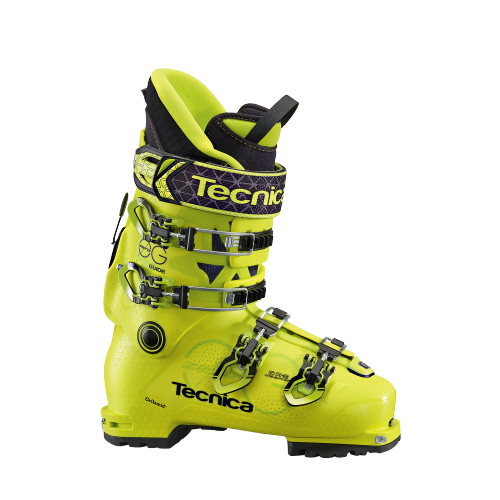 Tecnica Zero G Guide Pro
Tecnica Zero G Guide Pro
Tecnica was one of the first big alpine companies to really embrace tech binding-compatible AT boots back when others were just making alpine ski boots with a walk mode. The Zero G Guide Pro is a great boot in a light package that still has terrific alpine skiing abilities. Tecnica’s C.A.S. (Custom Adaptive Shape) shell is made from Grilamid, and is easy to modify for a foot shape. The shell is now a little narrower in the ankle, but still has extra instep room. Tecnica’s Quick Instep design also uses softer materials over the instep, so getting in and out is a breeze.

Doug Stewart, an examiner for the Eastern Division of the Professional Ski Instructors of America, is a bootfitter at Skiack in Burlington. He also teaches skiing and trains the ski school staff at Stowe Mountain Resort.

